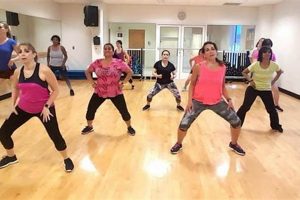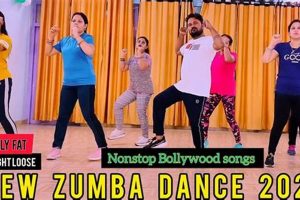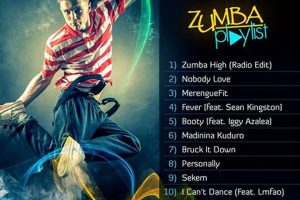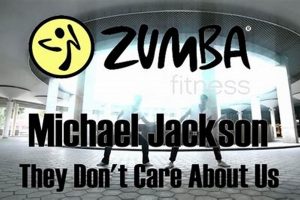The selection of music significantly influences the effectiveness and enjoyment of dance fitness programs. Tracks that resonate with participants and provide a high-energy atmosphere are crucial for a successful class experience. For instance, songs with strong, repetitive beats and culturally relevant rhythms often find favor among participants.
Music’s inherent ability to motivate and energize makes it a cornerstone of many fitness routines. Upbeat tempos and engaging melodies can enhance physical performance, improve mood, and create a sense of community within a group exercise setting. Historically, the integration of diverse musical styles has broadened the appeal of such programs, fostering inclusivity and sustained participation.
The following sections will explore specific characteristics of musical selections used in dance fitness, examining elements such as tempo, rhythm, and genre diversity. Furthermore, the impact of these musical choices on participant engagement and overall program success will be discussed.
Guidance in Selecting High-Engagement Musical Selections for Dance Fitness
The following guidelines provide insights into the selection process for music used in dance fitness programs, aiming to maximize participant engagement and enjoyment. The emphasis is on musical attributes that demonstrably contribute to a positive class experience.
Tip 1: Prioritize Upbeat Tempo: Musical selections should possess a tempo ranging from 130 to 145 beats per minute (BPM). This range facilitates high-energy movements and encourages sustained physical activity. Example: Latin rhythms frequently found in the 135 BPM range.
Tip 2: Incorporate Diverse Rhythms: Inclusion of varying rhythms, such as salsa, merengue, cumbia, and reggaeton, caters to diverse participant preferences and prevents monotony. This broad approach expands the program’s appeal and fosters inclusivity.
Tip 3: Evaluate Musical Authenticity: Selections should reflect genuine cultural expression. Authentic musical styles enhance the cultural immersion aspect of the dance fitness program. Example: Utilizing traditional instruments and vocal stylings characteristic of specific genres.
Tip 4: Emphasize Clear and Strong Beats: Music with prominent and easily discernible beats simplifies choreography execution. Clear rhythmic structure supports participants in maintaining correct form and timing, regardless of experience level.
Tip 5: Integrate Familiar Tunes: Incorporation of well-known songs can increase initial engagement. Familiarity can lower inhibitions and encourage participation among individuals new to dance fitness. Example: Remixes or adaptations of popular songs with suitable tempos.
Tip 6: Monitor Participant Feedback: Continuously solicit feedback regarding musical preferences. Adjustments based on participant input ensure the ongoing relevance and enjoyment of the program. This iterative process allows for personalized musical selection.
Tip 7: Consider Energy Flow: Design the playlist to create a structured energy flow, alternating between high-intensity and recovery tracks. This helps to avoid exhaustion and maintain engagement for a longer period.
By adhering to these guidelines, instructors can curate musical playlists that enhance the overall dance fitness experience, promoting participant satisfaction and sustained program adherence.
The subsequent sections will address the practical application of these musical selection principles in various dance fitness contexts.
1. Tempo (BPM)
Tempo, measured in beats per minute (BPM), constitutes a foundational element influencing the selection and popularity of musical pieces used in Zumba fitness programs. Its significance lies in dictating the pace of movements and the overall intensity of the exercise.
- Effect on Exercise Intensity
Tempo directly correlates with the energy expenditure during a Zumba workout. Higher BPMs necessitate faster movements, leading to increased cardiovascular activity and calorie burn. Conversely, slower tempos facilitate controlled movements and a focus on muscular engagement. The selection of appropriate BPM ranges is, therefore, crucial for tailoring the workout to specific fitness levels and objectives.
- Synchronization with Choreography
Effective choreography relies on a clear alignment between the music’s tempo and the steps performed. Songs with consistent BPMs allow for seamless transitions between dance moves, enhancing coordination and minimizing potential for injury. Instructors often modify choreography to accommodate variations in tempo, ensuring that movements remain synchronized and safe for participants.
- Impact on Participant Engagement
Music with an engaging tempo motivates participants and contributes to a positive workout experience. Songs with a BPM range of approximately 130-145 are generally favored in Zumba classes, as they provide a balance between high energy and manageable intensity. The selection of tempos that resonate with participants’ preferences is vital for sustaining motivation and adherence to the program.
- Variations in BPM for Workout Structure
Skilled Zumba instructors strategically employ variations in tempo throughout a class to structure the workout effectively. Higher BPM tracks are used during peak intensity periods to maximize calorie burn and cardiovascular benefits. Slower BPM tracks provide recovery periods and allow for focused muscle engagement. By alternating between tempos, instructors can optimize the fitness impact of the workout while maintaining participant engagement.
The consideration of tempo is, therefore, an integral aspect of musical selection for Zumba fitness programs. By understanding the impact of BPM on exercise intensity, choreography, participant engagement, and workout structure, instructors can optimize the effectiveness and enjoyment of Zumba sessions, contributing to the popularity and sustained appeal of these programs.
2. Rhythmic Variety
Rhythmic variety constitutes a critical element in determining the appeal and widespread adoption of music utilized in dance fitness programs. The incorporation of diverse rhythmic structures caters to a broader spectrum of participant preferences and significantly enhances the overall exercise experience.
- Cultural Music Genre Diversity
The inclusion of rhythms derived from various cultural origins significantly expands the appeal of musical selections. Examples include salsa, merengue, cumbia, reggaeton, and soca, each characterized by distinct rhythmic patterns and instrumentation. Integrating these diverse musical styles introduces participants to different cultural expressions, fostering a sense of inclusivity and preventing monotony. For instance, a Zumba class incorporating both a high-energy reggaeton track and a slower, more sensual salsa song demonstrates an understanding of the importance of rhythmic variety.
- Tempo Modulation Within Playlists
Varying the tempo, as measured in beats per minute (BPM), throughout a playlist is essential for maintaining participant engagement and optimizing the physiological benefits of the workout. Alternating between higher-tempo tracks, which elevate heart rate and calorie burn, and lower-tempo tracks, which allow for recovery and focused muscle engagement, contributes to a well-rounded fitness experience. A common approach involves transitioning from a high-energy Latin beat to a slower, more sensual Latin rhythm, offering participants a dynamic and balanced workout.
- Syncopation and Polyrhythms
Syncopation, the placement of emphasis on unexpected beats, and polyrhythms, the simultaneous use of two or more conflicting rhythms, add complexity and interest to musical selections. These rhythmic devices challenge participants to maintain coordination and enhance their sense of musicality. Songs that incorporate syncopated basslines or complex polyrhythmic percussion patterns can create a captivating and engaging workout experience, encouraging participants to focus and refine their movements. Certain songs, for example, merge a consistent 4/4 beat with offbeat percussive elements, producing an engaging effect.
- Instrumental and Vocal Textural Variation
The use of diverse instrumental arrangements and vocal styles contributes to rhythmic variety by creating contrasting textures and sonic landscapes. Incorporating tracks that feature different combinations of instruments, such as traditional Latin percussion, synthesizers, and acoustic guitars, adds depth and dimension to the music. Similarly, alternating between male and female vocalists, as well as incorporating songs with different vocal styles, such as rapping, singing, and chanting, can enhance the listening experience and prevent auditory fatigue.
In summation, rhythmic variety is not merely an aesthetic consideration, but rather a critical element that directly influences participant engagement, motivation, and the overall success of dance fitness programs. The strategic incorporation of diverse musical genres, tempos, syncopation, and instrumental arrangements creates a dynamic and engaging workout experience, contributing to the enduring popularity and effectiveness of Zumba.
3. Cultural Relevance
Cultural relevance significantly influences the acceptance and popularity of musical selections in dance fitness, particularly within Zumba programs. Songs that resonate with participants’ cultural backgrounds or introduce them to new, authentic cultural expressions often exhibit higher engagement levels. This connection stems from music’s inherent ability to evoke emotional responses and foster a sense of belonging. When participants recognize familiar rhythms, instruments, or lyrical themes from their own heritage, or when exposed to authentic representations of other cultures, it enhances the workout experience. For instance, a Zumba routine incorporating a popular salsa song from a well-known Latin American artist will likely generate greater enthusiasm among participants familiar with that genre than a song lacking cultural context. This positive association can lead to increased participation and overall program satisfaction.
The incorporation of music from diverse cultural traditions offers both opportunities and challenges. While celebrating cultural diversity enriches the experience, misrepresentation or appropriation can alienate participants. Therefore, instructors must ensure the respectful and accurate presentation of cultural elements. Choosing songs performed by artists who are deeply connected to their cultural heritage and providing contextual information about the music’s origins are crucial steps. Moreover, collaboration with community members or cultural experts can enhance the authenticity and sensitivity of the program. For example, if a Zumba class incorporates Bollywood-inspired music, consulting with someone knowledgeable about Indian dance and music can prevent misinterpretations and ensure respectful representation.
In conclusion, cultural relevance is a crucial component of successful Zumba programs. By selecting music that authentically represents diverse cultures, instructors can create inclusive and engaging workout experiences. Careful consideration must be given to ensure respectful representation and prevent cultural appropriation. Prioritizing authenticity and cultural understanding not only enhances the enjoyment of Zumba sessions but also fosters a deeper appreciation for diverse cultural traditions among participants. The ongoing evaluation of participant feedback and collaboration with cultural experts will facilitate the selection of culturally relevant music selections that foster a positive and enriching workout environment.
4. High Energy
High energy is a primary determinant of music popularity within Zumba programs. Music’s capacity to elevate participant engagement hinges on energy levels, thereby influencing workout effectiveness and enjoyment.
- Tempo as an Energizer
Tempo, quantified in beats per minute (BPM), serves as a fundamental energizing element. Higher tempos elicit faster movements, increasing cardiovascular activity and calorie expenditure. Musical selections typically found within successful Zumba playlists exhibit BPMs between 130 and 145. This range enables high-intensity exercise while maintaining participant coordination. For instance, a Latin dance track with a consistent 140 BPM fosters a sustained, high-energy workout. Music failing to meet this tempo threshold may prove inadequate for achieving desired fitness outcomes.
- Rhythmic Complexity and Drive
Rhythmic complexity amplifies music’s energizing effect. Intricate rhythmic patterns, including syncopation and polyrhythms, challenge participants and enhance engagement. Music employing diverse percussion instruments and dynamic rhythmic variations contributes to a heightened sense of energy. Conversely, repetitive or monotonous rhythms can diminish motivation and reduce workout intensity. A high-energy track utilizes varied percussive elements and dynamic rhythmic shifts to maintain elevated participant engagement.
- Instrumentation and Sonic Texture
Instrumentation significantly affects perceived energy levels. Music featuring instruments associated with high-energy genres, such as electronic dance music (EDM), Latin, and Caribbean rhythms, tends to be more effective in driving participant motivation. The strategic use of synthesizers, percussion, and vocal samples can create a sonic texture that is both stimulating and engaging. Furthermore, sonic clarity and dynamic range contribute to the overall perception of energy. Tracks with poor audio quality or limited dynamic range may fail to elicit the desired energizing effect.
- Lyrical Content and Vocal Delivery
Lyrical content and vocal delivery play a vital role in shaping the energy of musical selections. Songs with positive, uplifting lyrics and energetic vocal performances are more likely to resonate with participants and enhance their workout experience. Vocal techniques such as call-and-response and powerful ad-libs can further amplify the energizing effect of the music. Conversely, songs with negative or depressing lyrics may detract from the workout and diminish participant motivation. Vocal delivery is a critical factor in energizing the listener and enhancing the overall Zumba experience.
In summary, high energy is a multifaceted attribute that significantly impacts musical selection within Zumba programs. Factors such as tempo, rhythmic complexity, instrumentation, and lyrical content collectively determine the perceived energy levels of music and its capacity to drive participant motivation and engagement. Carefully considering these elements allows instructors to curate playlists that maximize workout effectiveness and foster a positive and energizing fitness experience.
5. Choreography Alignment
Choreography alignment represents a crucial element in determining the popularity and effectiveness of musical selections within Zumba fitness programs. The degree to which a song facilitates seamless integration with established dance routines directly impacts participant engagement and overall workout quality.
- Rhythmic Synchronization
Synchronization between musical rhythm and dance movements forms the bedrock of effective choreography. Songs featuring clear, consistent beats enable participants to execute steps with precision and coordination. Conversely, musical selections with complex or unpredictable rhythms may hinder choreography, leading to participant frustration and reduced workout effectiveness. Musical pieces typically employed in Zumba feature rhythmic patterns that support repeatable and easily digestible dance steps.
- Tempo Compatibility
Tempo compatibility ensures that the speed of the music aligns with the physical capabilities of the participants and the intended intensity of the workout. Songs with tempos that are either too fast or too slow can disrupt choreography, leading to discomfort or inefficiency. Musical tracks selected for Zumba routines generally adhere to a tempo range that promotes cardiovascular activity while allowing for controlled movements. Careful tempo selection supports both the physical demands and aesthetic aspects of the choreography.
- Phrase and Structure Harmony
The structure of a song, including its phrases, verses, and choruses, should complement the structure of the choreography. Seamless transitions between different sections of a song allow for the logical progression of dance movements, creating a cohesive and engaging workout experience. Musical pieces with predictable and well-defined structures facilitate the creation of easily learnable and repeatable choreography. Harmony between musical structure and choreographic structure is a hallmark of effective Zumba routines.
- Genre and Style Consistency
Maintaining consistency in genre and style throughout a Zumba routine enhances the overall aesthetic appeal and cultural relevance of the choreography. Musical selections that align with the chosen dance style create a more immersive and enjoyable experience for participants. Incongruent musical choices can disrupt the flow of the workout and detract from its overall effectiveness. Musical selection needs to fit with the style of movement.
The factors influencing choreography alignment illustrate its fundamental impact on the popularity of music used in Zumba. By prioritizing rhythmic synchronization, tempo compatibility, phrase and structure harmony, and genre and style consistency, instructors can curate musical playlists that optimize the effectiveness and enjoyment of Zumba workouts, leading to greater participant satisfaction and program adherence.
Frequently Asked Questions Regarding Popular Zumba Songs
The subsequent section addresses common inquiries pertaining to the selection and utilization of prevalent music in Zumba fitness programs, offering factual insights and clarifying potential ambiguities.
Question 1: What defines a musical selection as a popular choice within Zumba fitness classes?
Popularity is typically determined by factors such as frequency of use by certified instructors, consistent positive feedback from participants, and demonstrable effectiveness in enhancing workout engagement and adherence. Songs that reliably generate enthusiasm and elicit active participation within Zumba settings are generally considered popular.
Question 2: How does tempo, measured in beats per minute (BPM), influence the suitability of songs for Zumba routines?
Tempo exerts a direct influence on workout intensity. Tracks with a BPM range between 130 and 145 are generally optimal for Zumba, facilitating high-energy movements while enabling participants to maintain coordination. Deviations from this range can compromise workout effectiveness or participant comfort.
Question 3: Why is rhythmic variety considered a crucial element in selecting music for Zumba programs?
Rhythmic variety prevents monotony and caters to diverse participant preferences. Incorporation of musical styles such as salsa, merengue, cumbia, and reggaeton broadens the appeal of Zumba classes and fosters inclusivity. Monotonous rhythmic patterns can diminish participant engagement and reduce workout adherence.
Question 4: How does cultural relevance affect the acceptance and popularity of songs utilized in Zumba?
Cultural relevance enhances participant engagement by fostering a sense of connection and familiarity. Tracks that resonate with participants’ cultural backgrounds or introduce authentic cultural expressions often elicit greater enthusiasm. However, it is imperative to ensure respectful representation and avoid cultural appropriation when incorporating diverse musical styles.
Question 5: What role does instrumentation play in determining the effectiveness of music for Zumba?
Instrumentation significantly influences the energy levels and overall appeal of musical selections. Tracks featuring instruments associated with high-energy genres, such as Latin percussion, synthesizers, and drum machines, tend to be more effective in driving participant motivation. The strategic use of diverse instrumentation can enhance the sonic texture and create a more engaging workout experience.
Question 6: How does the degree of choreography alignment impact the selection of music for Zumba routines?
Choreography alignment is paramount. Tracks that seamlessly integrate with established dance routines facilitate participant coordination and enhance workout effectiveness. Musical selections with clear, consistent beats and predictable structures are generally more conducive to choreographic integration.
In essence, the selection of appropriate music constitutes a critical aspect of successful Zumba programs, impacting participant engagement, workout effectiveness, and overall program adherence. Prioritizing factors such as tempo, rhythmic variety, cultural relevance, instrumentation, and choreography alignment is crucial for optimizing the Zumba experience.
The subsequent section will explore case studies of successful Zumba programs, examining how these musical selection principles are implemented in practice.
Conclusion
The investigation into music frequently incorporated within Zumba fitness routines underscores several key determinants of its effectiveness. Tempo, rhythmic diversity, cultural resonance, energetic properties, and choreographic suitability collectively dictate a musical selection’s potential to foster participation and enhance overall program success. A comprehensive understanding of these elements is therefore paramount for instructors and program developers alike.
Continued analysis and adaptation based on participant feedback are essential for maintaining the relevance and efficacy of Zumba music selections. As musical tastes and fitness trends evolve, ongoing refinement of playlist curation strategies will ensure the sustained vitality and positive impact of these programs.







